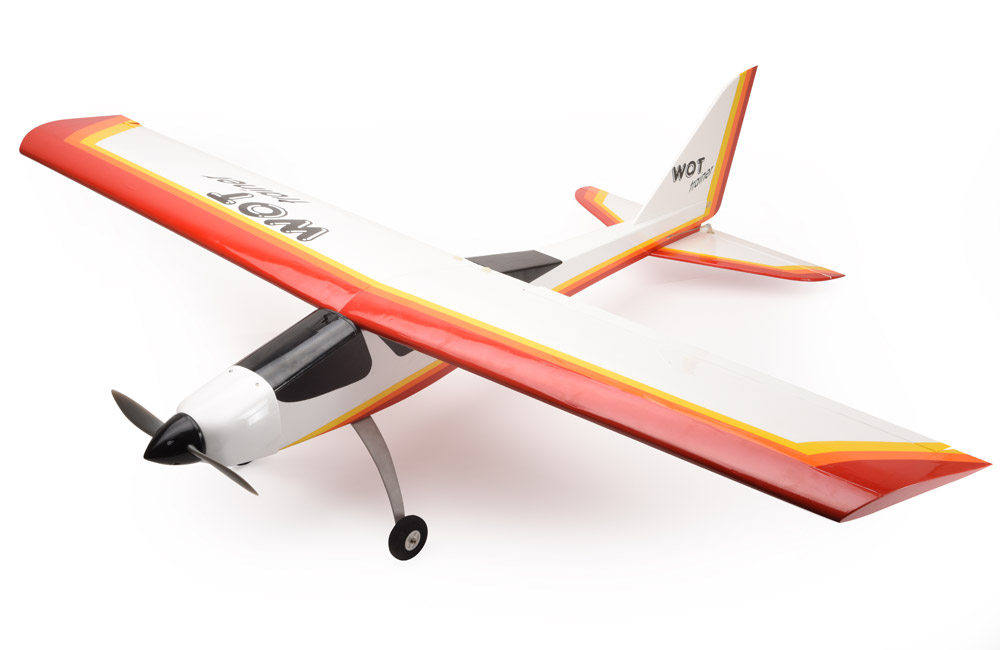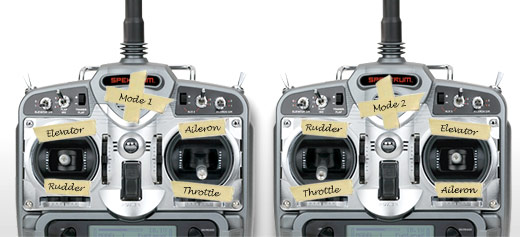For information or advice, relating to training and tuition, please contact a member of the DDMAC committee.
It is strongly recommended that anyone who is interested in taking up the hobby makes a visit to the local club flying field and seek advice, before making any purchase of an aircraft or radio equipment.
Unfortunately, many people do things the other way round and buy an aircraft and equipment first. They then realise it is not as easy as it looks. The equipment they have bought is often, not suitable for a beginner.
One of the most important things you must decide when you first start to fly, is which mode to fly on. The mode relates to what the sticks on the transmitter do i.e. which control surface they operate.
There are 4 different modes. Mode 1 and Mode 2 are the most common, with modes 3 and 4 rarely used.
The Radio Mode
Modern radio control equipment has advanced significantly in the last few years. In general, most radio sets have 4 channels or more. The transmitters have 2 sticks, which operate the 4 main functions that control the aircraft. These 4 functions are generally the throttle, aileron, rudder and elevator.
The position and layout of the functions on the transmitter is referred to as the mode.
The 2 most common modes, in use today, are Mode 1 & Mode 2.
Most modern radio sets today come set up on Mode 2. They have to be converted to the other modes. This is usually quite a simple process and only takes a couple of minutes.
Mode 1 sets have the following stick layout:
Throttle and aileron on the right-
Rudder and elevator on the left-
Mode 2 sets have the following stick layout:
Throttle and rudder on the left-
Aileron and elevator on the right-
Flying Tuition
We have a number of members who have agreed to act as club instructors (details below). These instructors are approved by the club committee. They offer their time free of charge, but please bear in mind, that they are not available all the time and do like to fly their own models too.
The club has two fixed wing training aircraft, which can be made available to any new members or prospective new members who wish to have a try at flying before making any purchase of a plane or equipment. The aircraft are set up with two transmitters, utilising the buddy facility (this will be explained and demonstrated).
The club tries to make use of the buddy box system wherever possible to teach new members to fly. The buddy box system allows two transmitters to be connected together (one master and one slave transmitter), allowing the instructor to take control of the model quickly when needed. The system will be fully explained and demonstrated to any new members wishing to utilise it (it’s a lot easier and safer than trying to snatch a transmitter from a learner who has got into difficulties).
The club try to hold a regular tuition and advice session, on a Tuesday afternoon from 12.30pm to 4.30pm at the DDMAC flying field. These sessions are subject to the weather conditions & availability of an instructor on the day.
The club utilise a secure members ‘WhatsApp’ group for members to use to see who is going to the field and whether any training sessions are going ahead or not.
Flying Solo
You must hold a BMFA ‘A’ Certificate for the discipline that you want to fly (fixed wing, helicopter or multi rotor) before you can fly solo, without the supervision of a club approved instructor or an authorised flying supervisor at the DDMAC airfield (full details in the club rules).
Members who hold a BMFA ‘A’ helicopter certificate will be allowed to fly multi rotor models solo, without taking the separate multi rotor test.
Safe flying is paramount and the aim is to get any new flyers to pass the BMFA ‘A’ Certificate for the discipline they fly, to enable them to fly on their own. The club has a number of BMFA qualified examiners, available to help, advise and encourage you to take and pass the BMFA ‘A’ and ‘B’ achievement certificates.
A visit to the DDMAC flying field on most Saturday or Sunday afternoons (weather permitting) will usually find a number of competent pilots willing to assist and offer advice.


Typical Fixed Wing Training Aircraft
The above are typical training aircraft that are suitable to learn to fly with. Most trainers are high wing aircraft with some dihedral on the wing (angle at which the wings join at the centre). This makes them more stable and in general easier to control.
There are numerous trainers on the market today, from light foam ones, to the more traditional built up wooden structures.
Before you decide which training aircraft to buy, come down to the flying field and see what other members use, before you make your choice.
DDMAC Club Instructors & BMFA Examiners
Name Fixed Wing Instructor Helicopter Instructor Mode 1 or 2 BMFA Examiner
Bob Brown Yes Yes 1 Fixed Wing
Mick Illingworth Yes No 1 Fixed Wing
Martin Lynn Yes Yes 1 Fixed Wing
Dave Wadsworth Yes Yes 2 No
David Rourke Yes Yes 2 No
Colin Barker Yes No 2 No
Graham Worfolk Yes No 2 No

